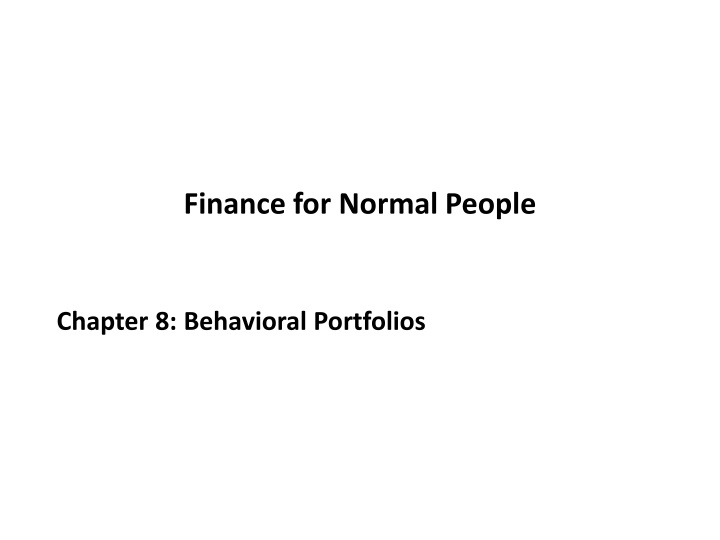
Behavioral Portfolios in Finance
Explore the concept of behavioral portfolios in finance, comparing Mean-Variance Portfolio Theory (MVPT) with Behavioral Portfolio Theory (BPT). Learn about efficient portfolios on the mean-variance frontier and the behavioral-wants frontier, satisfying different investor preferences. Discover how portfolios can meet utilitarian benefits as well as expressive and emotional needs, such as social responsibility and social status.
Download Presentation

Please find below an Image/Link to download the presentation.
The content on the website is provided AS IS for your information and personal use only. It may not be sold, licensed, or shared on other websites without obtaining consent from the author. If you encounter any issues during the download, it is possible that the publisher has removed the file from their server.
You are allowed to download the files provided on this website for personal or commercial use, subject to the condition that they are used lawfully. All files are the property of their respective owners.
The content on the website is provided AS IS for your information and personal use only. It may not be sold, licensed, or shared on other websites without obtaining consent from the author.
E N D
Presentation Transcript
Finance for Normal People Chapter 8: Behavioral Portfolios
Behavioral Portfolios Standard finance Mean-variance portfolio theory (MVPT) Behavioral finance Behavioral portfolio theory (BPT)
Behavioral portfolios Mean-Variance Portfolio Theory 1. Efficient portfolios are on the mean-variance frontier Behavioral Portfolio Theory 1. Efficient portfolios are on the behavioral-wants frontier
Behavioral portfolios Mean-Variance Portfolio Theory 2. Portfolios on the mean-variance frontier satisfy wants for utilitarian benefits (high expected returns and low risk) Behavioral Portfolio Theory 2. Portfolios on the behavioral-wants frontier satisfy wants for utilitarian benefits, but also for expressive and emotional, benefits (e.g. sincere social responsibility, high social status)
Figure 8-1: A Mean-Variance Frontier and Portfolio C on the Frontier Expected Returns Portfolio C Standard Deviation of Returns
Figure 8-2: A Mean-Variance Frontier and a Behavioral-Wants Frontier Expected Returns Mean-Variance Frontier Portfolio E Behavioral Wants Frontier Portfolio F 3.72% Current Portfolio D Standard Deviation of Returns
Figure 8-3: A Nutrition-Cost Frontier and a Behavioral-Wants Frontier Level of Nutrition Nutrition-Cost Frontier Stigler's Food Portfolio Nutrition for a Moderatel y Active Man Weighing 154 lbs Behavioral Wants Frontier Dietitians' Food Portfolio Annual Cost $39.93 $100.00
Behavioral portfolios Investors wants and the behavioral-wants frontier Wants for social responsibility
Figure 8-4: A Mean-Variance Frontier and a Behavioral-Wants Frontier Satisfying Wants For Social Responsibility Expected Returns Mean-Variance Frontier 3.00% Behavioral Wants Frontier Satisfying Wants For Social Responsibility Standard Deviation of Returns
Behavioral portfolios Investors wants and the behavioral-wants frontier Wants for social responsibility Wants for patriotism and familiarity Wants for pride and avoidance of regret Wants for adherence to convention
Behavioral portfolios Correcting cognitive and emotional errors The roles of correlations and standard deviations in return gaps and the benefits of diversification Table 8-2: Estimated Annual Return Gaps between Returns of Two Investments with Varying Combinations of Correlation and Standard Deviation (The standard deviation is the average of the standard deviations of the returns of the two investments) Standard Deviation 15.00% 1.41% 4.47% 6.32% 0.5 10.00% 0 14.14% Correlation 10.00% 0.99 0.9 0.8 20.00% 2.83% 8.94% 12.65% 20.00% 28.28% 2.12% 6.71% 9.49% 15.00% 21.21%
Figure 8-5: Return Gaps between U.S. and International Stocks 42.14% 33.62% 28.76% 27.16% 21.36% 17.39% 17.28% 17.12% 17.11% 16.44% 15.78% 15.72% 12.66% 12.39% 11.60% 6.37% 14 5.59% 8 1.08% US 1 Int'l 6 13 18 11 11 12 9 -3.44% 16 -13.33% -37.04% -45.24% 2004 2005 2006 2007 2008 2009 2010 2011 2012 2013 2014
Figure 8-6: Return Gaps between U.S. and International Stocks (Rolling 12-month differences between the returns of the S&P 500 Index and the returns of the MSCI EAFE Index) 80% Returns of U.S. stocks exceed returns of international stocks 60% 40% Percent Outperformance 20% 0% 20% 40% 60% 80% 1973 1980 1987 1994 2001 2008 Returns of international stocks exceed returns of U.S. stocks
Behavioral portfolios Mean-Variance Portfolio Theory 3. Investors consider portfolios as a whole Behavioral Portfolio Theory 3. Investors consider portfolios as layered pyramids, where each layer is a mental account or "bucket" associated with a want and goal
Figure 8-11: Behavioral-wants portfolios as pyramids of wants and associated goals Want and Associated Goal: Upside Potential Utilitarian Benefits: Riches Expressive and Emotional Benefits: High social status and pride Want and Associated Goal: Downside Protection Utilitarian Benefits: Protection from Poverty Expressive and Emotional Benefits: Financial independence and freedom from fear
Behavioral portfolios Mean-Variance Portfolio Theory 4. Investors measure risk by the variance of returns Behavioral Portfolio Theory 4. Investors measure risk by the probability of shortfall from a goal, the amount of shortfall, or a combination of both
Behavioral portfolios Mean-Variance Portfolio Theory 5. Investors have a single risk aversion in their portfolio as a whole Behavioral Portfolio Theory 5. Investors have many risk aversions one for each mental account
Behavioral portfolios Mean-Variance Portfolio Theory 6. Investors are always risk-averse, where risk is measured by the variance of returns Behavioral Portfolio Theory 6. Investors are always risk averse, where risk is measured by the probability of shortfall from a goal, the amount of shortfall, or a combination of both
Behavioral portfolios An investor with $100,000 of current wealth and $130,000, a high target wealth, by the terminal date, a year from today The investor can form portfolios composed of one of two stocks, L (Lottery) and M (Moderate), or combinations of the two L (Lottery) is a lottery-like stock, with a negative 10% expected return and a high 80% standard deviation of returns M (Moderate) is a stock with a positive 20% expected return and a low 12% standard deviation of returns The correlation between the returns of L (Lottery) and M (Moderate) is zero
Behavioral portfolios The expected wealth of an investor who invests her entire $100,000 current wealth in L (Lottery) is $90,000 The 80% standard deviation amounts to $72,000 The expected wealth of an investor who invests her entire $100,000 current wealth in M (Moderate) is $120,000, The 12% standard deviation of returns amounts to $14,400
Figure 8-7: The distribution of wealth at the terminal date if $100,000 is invested fully in stock M (Moderate) or stock L (Lottery) M (Moderate) L (Lottery) $120,000 $90,000 Wealth at terminal date
Figure 8-8: Mean-Variance Frontier with Stocks M (Moderate), L (Lottery) and Portfolio LST (Lowest) A 100% M portfolios is on the mean-variance frontier but a 100% L portfolio is not Expected Wealth 100% M (Moderate) $120,000 $118,845 LST - 96.15% M (Moderate) and 3.85% L (Lottery) 100% L (Lottery) $90,000 $72,000 $14,120 $14,400 Standard Deviation of Wealth
Figure 8-9: Behavioral-wants frontier when target wealth, $130,000, is high relative to $100,000 current wealth. A 100% L portfolio is on the behavioral-wants frontier, and so is a 100% M portfolio Expected Wealth 100% M (Moderate) $120,000 $105,882 47.06% L (Lottery) 52.94% M (Moderate) Probability of shortfall from $130,000 target wealth $90,000 100% L (Lottery) 75.63% Probability of shortfall from $130,000 target wealth 71.07%
Behavioral portfolios An investor with a target wealth of $100,000, a low terminal wealth relative to his current $100,000 wealth Investors with low target wealth relative to their current wealth might find that a portfolio composed solely of L (Lottery) is not on the behavioral-wants frontier
Figure 8-10: Behavioral-wants frontier when target wealth, $100,000, is low relative to $100,000 current wealth. A 100% L portfolio is not on the behavioral-wants frontier. Only a 100% M is on the behavioral-wants frontier Expected Wealth 100 % M (Moderate) $119,700 $105,000 $90,000 100% L (Lottery) Probability of shortfall from $100,000 target wealth 8.24% 44.58% 55.52%
Behavioral portfolios Combine the two investors into one with $200,000 of current wealth in two mental accounts: an upside potential mental account with $100,000 of current wealth and $130,000 target wealth and a downside protection mental account with $100,000 of current wealth and $100,000 of target wealth
Figure 8-12: The Roles of Jobs and Portfolios Among Younger and Older People Portfolio: Job: Upside Potential Upside Potential Job: Portfolio: Downside Protection Downside Protection
Figure 8-13: Behavioral-wants portfolio with three wants and their mental accounts Retirement, education, and bequest Bequest Want Allocation: $50,000 Target Date: 25 Years Target Annualized Return: 12% Target Wealth: $650,003 Education Want Allocation: $150,000 Target Date: 3 Years Target Annualized Return: 8% Target Wealth: $188,957 Retirement Want Allocation: $800,000 Target Date: 15 Years Target Annualized Return: 6% Target Wealth: $1,917,247
Table 8-3: Mental Accounts of Wants and the Portfolio as a Whole Mental Accounts of Wants Allocation to Mental Account $50,000 Target Date Target Annualized Return Target wealth at the Target Date Bequest Want Education Want Retirement Want 25 years 12.00% $850,003 $150,000 3 years 8.00% $188,957 $800,000 15 years 6.00% $1,917,247
Table 8-3: Mental Accounts of Wants and the Portfolio as a Whole Retirement Want Education Want Bequest Want Portfolio as a Whole $1,000,000 45.58% 35.36% Allocations Bond Fund Conservative Stock Fund Aggressive Stock Fund Total Expected Return Std. Deviation $800,000 52.51% 31.06% $150,000 29.40% 45.40% $50,000 -16.80% 74.06% 16.43% 25.20% 42.74% 19.06% 100% 100% 100% 100% 6.00% 10.45% 8.00% 15.23% 12.00% 25.28% 6.60% 11.85%
Expected Returns Bequest Want Educational Want Overall Portfolio Retirement Want Standard Deviation of Returns
Behavioral portfolio theory in practice MoneyGuidePro Wealthcare Brunel Associates Mutual fund companies
Table 8-4:Schwab Model Portfolio and Optimized Mean-Variance Portfolio Moderate Portfolio Optimized Mean-Variance Portfolio Schwab Portfolio Difference Large-capitalization Stocks Small-Capitalization Stocks International Stocks Bonds Cash Total Expected Annual Return of the Portfolio Std. Dev of the Annual Return of the Portfolio 35% 10% 15% 35% 5% 100% 0% 40% 5% 55% 0% 100% 35% -30% 10% -20% 5% 0% 10.34% 11.00% -0.66% 11.73 11.73 0.00
Figure 8-18: Strategic asset allocation, tactical asset allocation, and security selection Movements on the frontier and movements of the frontier Expected Returns 2 C 1 B A Standard Deviation of Returns




